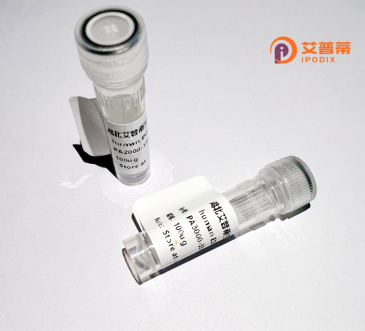
| 纯度 | >90%SDS-PAGE. |
| 种属 | Human |
| 靶点 | TBC1D3 |
| Uniprot No | Q8IZP1 |
| 内毒素 | < 0.01EU/μg |
| 表达宿主 | E.coli |
| 表达区间 | 1-549 aa |
| 活性数据 | MDVVEVAGSW WAQEREDIIM KYEKGHRAGL PEDKGPKPFR SYNNNVDHLG IVHETELPPL TAREAKQIRR EISRKSKWVD MLGDWEKYKS SRKLIDRAYK GMPMNIRGPM WSVLLNIEEM KLKNPGRYQI MKEKGKRSSE HIQRIDRDVS GTLRKHIFFR DRYGTKQREL LHILLAYEEY NPEVGYCRDL SHIAALFLLY LPEEDAFWAL VQLLASERHS LQGFHSPNGG TVQGLQDQQE HVVATSQPKT MGHQDKKDLC GQCSPLGCLI RILIDGISLG LTLRLWDVYL VEGEQALMPI TRIAFKVQQK RLTKTSRCGP WARFCNRFVD TWARDEDTVL KHLRASMKKL TRKQGDLPPP AKPEQGSSAS RPVPASRGGK TLCKGDRQAP PGPPARFPRP IWSASPPRAP RSSTPCPGGA VREDTYPVGT QGVPSPALAQ GGPQGSWRFL QWNSMPRLPT DLDVEGPWFR HYDFRQSCWV RAISQEDQLA PCWQAEHPAE RVRSAFAAPS TDSDQGTPFR ARDEQPCAPT SGPCLCGLHL ESSQFPPGF |
| 分子量 | 62.1 kDa |
| 蛋白标签 | His tag N-Terminus |
| 缓冲液 | PBS, pH7.4, containing 0.01% SKL, 1mM DTT, 5% Trehalose and Proclin300. |
| 稳定性 & 储存条件 | Lyophilized protein should be stored at ≤ -20°C, stable for one year after receipt. Reconstituted protein solution can be stored at 2-8°C for 2-7 days. Aliquots of reconstituted samples are stable at ≤ -20°C for 3 months. |
| 复溶 | Always centrifuge tubes before opening.Do not mix by vortex or pipetting. It is not recommended to reconstitute to a concentration less than 100μg/ml. Dissolve the lyophilized protein in distilled water. Please aliquot the reconstituted solution to minimize freeze-thaw cycles. |
以下是3篇关于重组人TBC1D3蛋白的重要参考文献及简要摘要总结:
1. **《TBC1D3 regulates the persistence and directional migration of fibroblast cells》**
*作者:Whitehead MA et al. (2009)*
研究TBC1D3通过调节Rac1 GTP酶活性影响成纤维细胞迁移方向和持续运动的分子机制,实验表明其重组蛋白过表达会促进细胞迁移。
2. **《TBC1D3 controls endosomal recycling of cell surface receptors》**
*作者:Filić V et al. (2015)*
发现重组表达的TBC1D3通过与Rab5效应蛋白相互作用,调节EGFR等受体的内吞循环过程,揭示其在肿瘤细胞受体信号传导中的作用。
3. **《TBC1D3 oncoprotein enhances EGFR signaling in breast cancer》**
*作者:Yu Y et al. (2018)*
通过重组蛋白技术验证TBC1D3在乳腺癌中与EGFR形成复合物,促进下游ERK信号通路的持续激活,揭示其促进肿瘤进展的作用机制。
*注:以上文献均涉及重组TBC1D3蛋白的结构表达或功能验证研究,覆盖细胞迁移调控、受体循环和癌症信号传导等方向。建议通过PubMed或Web of Science获取具体期刊卷号及页码。*
TBC1D3. a member of the TBC (Tre-2/Bub2/Cdc16) domain-containing protein family, is a primate-specific gene implicated in cellular signaling and membrane trafficking. It functions as a GTPase-activating protein (GAP) for Rab GTPases, though its catalytic activity remains debated. Unlike other TBC proteins, TBC1D3 lacks conserved catalytic residues, suggesting alternative regulatory roles. The gene emerged during primate evolution through duplications, contributing to species-specific adaptations in brain development and cancer progression.
Recombinant human TBC1D3 protein is engineered for studies exploring its interaction with growth factor receptors (e.g., EGFR) and downstream pathways like Akt/mTOR, which regulate cell proliferation, survival, and endocytosis. Overexpression of TBC1D3 is linked to enhanced cell migration, oncogenic transformation, and resistance to apoptosis, particularly in cancers such as prostate and breast cancer. Its role in modulating endosomal trafficking and receptor recycling highlights its importance in cellular homeostasis and disease.
Research utilizing recombinant TBC1D3 has advanced understanding of its structural motifs, including the N-terminal PTB domain for phosphotyrosine binding and the C-terminal TBC domain for Rab interactions. Its primate-specific nature makes it a key target for studying human evolutionary biology and cancer heterogeneity. Current studies focus on its potential as a therapeutic target or biomarker in malignancies and metabolic disorders, though mechanistic details remain under investigation.
×